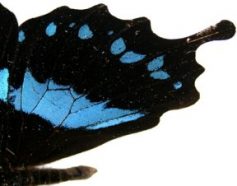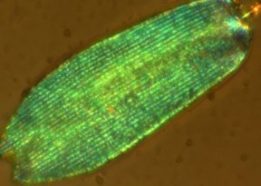A butterfly’s electric glow
The brilliant color of some butterfly wings comes from tiny scales that absorb and give off light in a special way.
By Emily Sohn
The blue-green streaks of a swallowtail butterfly’s wings are more than just beautiful. They’re also a lesson in physics.
 |
|
The bands of brilliant color on this butterfly’s wing are produced from tiny scales on the wing’s surface.
|
| Image courtesy of Peter Vukusic/University of Exeter |
Swallowtails that belong to a group called Princeps nireus actually have fluorescent wings. This means that when the wings absorb a special type of light, called ultraviolet light (or “black light”), they give off a bright blue-green glow. The glow that they give off has a longer wavelength than the ultraviolet light they absorb.
Physicist Peter Vukusic of Exeter University wanted to figure out why the wings are unusually bright. So, he took a close-up look.
Butterfly wings are covered with hundreds of thousands of colored scales, like tiles covering a roof. The scales are made of cuticle, a material that is similar to human fingernails. Vukusic and his colleagues used highly sensitive microscopes to look at individual scales.
 |
|
Optical microscope image of a single scale from a butterfly wing.
|
| Image courtesy of Peter Vukusic/University of Exeter |
Their pictures show that each scale has three vertical levels. The bottom level is itself split up into three more layers, like an Oreo cookie, with an air space sandwiched between two layers of cuticle. Each layer is about 90 nanometers thick. One nanometer is one-billionth of a meter. A human hair is about 80,000 nanometers wide.
The middle level is a 1.5-micrometer-thick air space, held together by columns of cuticle. One micrometer is one-millionth of a meter, or 1,000 nanometers.
Finally, the top level is made of cuticle arranged in a sort of honeycomb pattern, 2 micrometers thick. The honeycomb holds tiny cylinders of air, measuring 240 nanometers across. The walls of these cylinders hold the pigments that cause the wings to glow, or fluoresce.
The wings seem to achieve their bright glow in two ways, the scientists conclude. First, the pigment-filled cylinders in the top level and the Oreo sandwich in the bottom level cause all of the fluorescence to reflect out of the top of the wing. Second, the bottom level adds even more blue-green light by reflecting sunlight that filters down and hits it.
 |
|
Peter Vukusic with several different butterflies that have wings covered with special scales that brighten the color.
|
| Image courtesy of Peter Vukusic/University of Exeter |
Some electronic devices called light-emitting diodes (LEDs) work in a remarkably similar way. LEDs light up the numbers on clocks and watches and show when appliances are on, among many other jobs.
It’s another amazing example of technology imitating nature, whether intended or not.—E. Sohn
Going Deeper:
Cunningham, Aimee. 2005. Way to glow: Butterfly-wing structure matches high-tech lights’ design. Science News 168(Nov. 19):324. Available at http://www.sciencenews.org/articles/20051119/fob3.asp .







